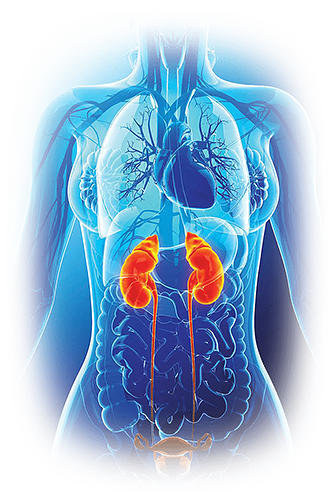Login
For Clinician Providers
For Clinician Providers
For Patients
PROSTATE HEATH INDEX (phi)
The Prostate Health Index (phi) is a calculation that uses a combination of three blood tests to produce a “phi score.” This score provides more information about what elevated PSA levels might mean and the probability of finding prostate cancer on biopsy.*
The benefits of phi
phi is
- A simple blood test for prostate cancer screening with FDA approval
- A tool to reduce negative biopsies and provide more confidence in your biopsy decisions
- A recommendation by the National Comprehensive Cancer Network (NCCN) Guidelines for PCa Early Detection
The Prostate Health Index (phi) is a calculation that uses a combination of three blood tests to produce a “phi” score: total PSA, free PSA and p2PSA. This score gives more accurate information on what an elevated PSA level might mean and the probability of finding cancer on biopsy.*
More confidence before a biopsy
Results from a prospective, multicenter clinical trial found that phi can provide better risk stratification versus % of PSA to identify patients that actually need a biopsy. More than 80 published clinical papers and meeting abstracts demonstrate the health benefits and economic value of phi.
Check out the clinical brochure >>
he power of phi
phi comprises a combination of three tests:
- PSA
- free PSA
- p2PSA
The new p2PSA assay is specific to measuring [-2] proPSA. The [-2] proPSA biomarker is an isoform of free PSA that was identified as the most prostate cancer-specific form found in tumor extracts (1). The PSA, free PSA and p2PSA results are combined in the Beckman Coulter Access instrument to calculate a probability of prostate cancer.
Better Detection to Reduce Negative Biopsies
PSA is a widely used prostate cancer screening tool. However, with PSA’s limited specificity, a more precise tool is needed for prostate cancer detection. That tool was found in the discovery of phi. The phi score provides better risk stratification to identify patients who need a biopsy.
How is phi used in clinical practice?
Because phi is three times more specific than PSA for detecting prostate cancer1, it fills the diagnostic gap between PSA testing and a prostate biopsy.
Combined with family and patient history, the phi results can be used to determine the best individualized patient management decisions.
What does the phi score mean?
Table 1 represents clinical study data analyzed to estimate an individual patient’s probability of having detectable prostate cancer based on Beckman Coulter phi results, when that patient has a PSA, in the diagnostic gray zone, between 4 and 10 ng/mL.2 At phi cut offs between 27 to 55, the probability of cancer ranged from 16.8% to 50.1%.2
| phi Range* | Probability of Cancer | 95% Confidence Interval |
|---|---|---|
| 0-26.9 | 9.8% | 5.2%-15.4% |
| 27.0-35.9 | 16.8% | 11.3%-22.2% |
| 36.0-54.9 | 33.3% | 26.8%-39.9% |
| 55.0+ | 50.1% | 39.8%-61.0% |
Table 1: Probability of prostate cancer based on phi results.1
Frequently asked questions (FAQs)
Q: Is phi (p2PSA) FDA-approved?
A: Yes, phi (p2PSA) received FDA approval in June 2012.
Q: Is phi in the National Comprehensive Cancer Network (NCCN) Guidelines?
A: Yes, phi was first added to the NCCN Guidelines in 2014.
Q: Are there any clinical studies on phi available?
A: Yes. There are more than 80 published studies on phi from around the world. Your Beckman Coulter representative can provide a summary of these clinical studies.
Q: Do you have to run Beckman Coulter’s PSA and fPSA assays to calculate phi?
A: Yes. phi is calculated using the test results from Beckman Coulter’s PSA, fPSA and p2PSA, all using the same method of calibration.
Q: Is phi reimbursed?
A: CPT coding for reporting the calculation of phi is similar to coding for reporting the calculation of %free PSA. For %free PSA, labs have billed for both the PSA and free PSA tests when reporting %free PSA results. For phi, three national organizations, (American Urology Association / PRS Urology, CodeMap of Wheaton Partners, LLC) have all recommended that when reporting phi results, labs should bill for the PSA (CPT 84153), freePSA (CPT 84154), and p2PSA (CPT 86316) tests. All three CPT codes within the recommendations are listed on the Medicare Clinical Lab Fee Schedule (MCLFS).
Q: Is phi positioned as a first line repeat/confirm PSA or as a reflex after PSA is confirmed and in the 4 to 10 ng/mL range?
A: The phi labeling indicates it should be run after confirmation that PSA is in the 4-10 ng/mL range.*** This indication extends to both initial and repeat biopsies.
*The phi results are intended to be used as an aid in distinguishing prostate cancer from benign prostatic conditions in men 50 years of age and older with total PSA results in the 4 – 10 ng/mL range and negative digital rectal examination (DRE) findings.
References:
- Loeb S, Sanda MG, Broyles DL, et al. The prostate health index selectively identifies clinically significant prostate cancer. J Urol. 2015;193(4):1163-9.
- Beckman Coulter Access Hybritech p2PSA Instructions for Use
How to get phi
Register your contact details and set up an account with us.



